Sheldon Brown's
Bicycle Glossary Ha - Hi

|
![]()
For an explanation of this design, see my wheelbuilding article.
With half-step gearing, the larger shifts are made with the rear derailer, and the front is for fine tuning. This allows an 8- or 10-speed set up to have a reasonable range with fairly close spacing of the gears. One downside of half-step is that it uses all possible combinations, including those that run the chain at a fairly severe angle. This was not a big deal in an 8-speed rig, but waskind of marginal for 10-speeds. Another serious disadvantage is that every other shift in the normal sequence is a double shift (front and rear derailers simultaneously). These issues are largely overcome with modern handlebar-end index shifters and narrow-spaced cassettes, but half-step requires mixing and matching sprockets these days -- no manufacturer offers an appropriate ready-made cassette.
Half-step gearing is most suitable for riding in flat terrain, where shifting is rare. It allows finer gradations to get as close to the "ideal" gear for the particular wind conditions as possible, and a wide range with even spacing.
Modern multi-range shift patterns use larger jumps on the chainwheels to select general ranges of gears, and fairly closely-spaced 7-or-more-speed clusters for the fine tuning. This greatly simplifies the shifting pattern, allowing constant adjustment to different grades in rolling terrain, with only occasional need for a double shift.
See my Article on Gear Theory.
Conventional handlebars are divided broadly into two styles: "drop" and "upright"
| Handlebar dimensions | ||||
|---|---|---|---|---|
| Stem Clamp Size |
Grip Area Size |
Application | ||
| 22.2 mm | 7/8" | 22.2 mm | 7/8" | Steel bars. Mainly BMX, older Mountain bike bars. |
| 23.8 mm | 15/16" | 22.2 mm | 7/8" | Obsolete British size for steel handlebars, common on older 3-speeds. This size was also used for older British steel drop bars. |
| 25 mm | 23.5 mm | Obsolete French size. | ||
| 25.4 mm | 1" | 22.2 mm | 7/8" | Standard I.S.O. size, used on the vast majority of newer bicycles with upright handlebars. This size was formerly common for steel drop bars. |
| 25.4 mm | 1" | 23.8 mm | 15/16" | Standard I.S.O. size, used on most bicycles with drop handlebars. Also used on older British aluminium upright handlebars. |
| 25.8 mm | 23.8 mm | 15/16" | Unofficial in-between size used by some Italian handlebar makers for handlebars designed to be usable in either ISO (25.4) or Italian (26.0) size stems. | |
| 26.0 mm | 23.8 mm | 15/16" | Italian standard for drop bars, other bars made to fit Italian stems and some high-end aftermarket drop bars. This is sometimes incorrectly called "road" size. |
|
| 26.4 mm | 23.8 mm | 15/16" | Older Cinelli and Cinelli copies. Cinelli changed over to 26.0 mm in 1998. | |
| 27 mm | 23.8 mm | 15/16" | Titan (obsolete). | |
| 31.8 mm | 1 1/4" | 23.8 mm | 15/16" | Road oversized. |
![]()
![]()
Sometimes incorrectly referred to as "handlebar ribbon." This mistake results from a translation error. (in French and Italian, there is no distinction between "ribbon" and "tape.")
| Dropout with built-in hanger | Plain dropout | Plain dropout with adapter claw |
|---|---|---|
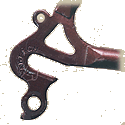 |
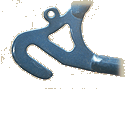 |
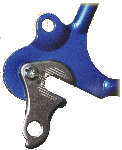 |
![]()
![]()
This is a very complicated technology, with very ancient roots. For many applications, such as sprockets and bearings you want a very hard surface to the part, but the inside of the part should be treated to a lesser hardness so as to avoid excessive brittleness and breakage.
A headset consists of four races plus associated parts:
The adjustable race is secured by either a:
The images below show how to identify whether a headset is threaded or threadless.
Threaded HeadsetNote wrench flats on locknutand top threaded race. 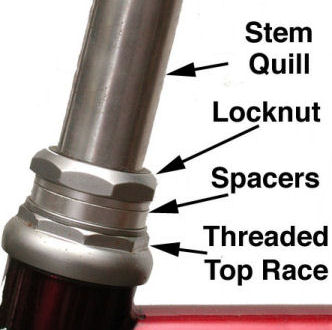 |
Threadless HeadsetNote pinch bolts on stem.and no wrench flats. 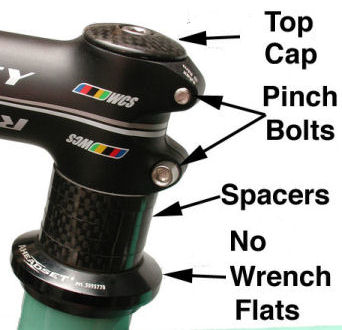 |
|---|
If you want to replace one headset with another, you must take into account the stack height of the new headset. There are other variations, in dimensions and in how parts are sccured. .
![]()
![]()
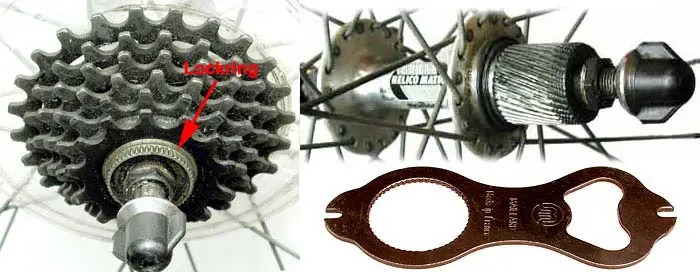
Both hub flanges were 1mm farther to the left than those of a normal hub, causing increased dish in the rear wheel, and persistent spoke breakage problems. Many loyal Helicomatic fans tout the ease with which the cassette may be removed for spoke replacement as a great virtue, but if the hub were better designed, it wouldn't break so many spokes!
These hubs were prone to bearing problems as well. Due to clearance requirements, they couldn't fit the normal 9 1/4" bearing balls, so they used 13 5/32 balls on the right side. These didn't hold up well. The cones tended to wear rapidly, and replacement cones are no longer available to fit these hubs.
Hellenic stays were introduced by (and named for) the British frame builder Fred Helens in 1923, and have been used off-and-on since by frame builders who wish to make their frames visually distinctive. They are of no practical value, and often cause un-necessary complication in brake-cable routing, luggage-rack attachment and installation of frame pumps. The are also slightly heavier than normal frame construction.
Recent users of this design include GT, Huffy and Nash bar.
A protective hat. The so-called "leather hairnet" was commonly worn by bicycle racers until better designs with actual impact protection superseded it. A few cyclists, notably Dr. Eugene Gaston, medical columnist for Bicycling magazine, had taken to wearing hockey or mountaineering helmets around 1970. Club riders and racers saw the need for head protection, but there was not yet a helmet optimized for best protection compatible with a cyclist's need for light weight, unobstructed vision and ventilation. Around 1973, Mountain Safety Research introduced a modified mountaineering helmet which used cloth webbing attached by eight deformable side clips to provide impact absorption. MSR later added EPS (expanded polystyrene) foam inserts between the webbing straps. The next year, Bell introduced the Bell Biker, the first helmet designed from scratch specifically for bicycling. It used EPS as its impact-absorbing material, and had tapered ventilating inlets, as do most other bicycle helmets made since. Bicycle helmets are designed to mitigate the impacts resulting from a fall to the ground from riding height. These impacts are entirely able to cause permanent brain injury or fatalities, and account for most impacts in bicycle crashes.
![]()
![]()
He did a lot of pioneering work on suspension designs for bicycles, and developed a bicycle seat that was based on an upside-down dropped handlebar with furniture webbing wrapped between the two straight sections.
He was also known for roller demonstrations where he would perform a strip-tease (down to his shorts), then put all his clothes back on again while riding on the rollers. A very cool guy.
High gears are for going fast, when the terrain permits. The rider must push much harder on the pedals in a high gear, so high gears are not suitable for lower-speed riding, due to the great strain that hard, slow pedaling puts on the joints.
Before the use of chain drive, bicycles had direct drive. The cranks were directly attached to the hub of the drive wheel. The larger the wheel, the farther the bicycle would move with each turn of the pedals. The diameter of the drive wheel determined the gear of the bicycle. The larger the wheel, the higher the gear.
With a chain-driven "safety" bicycle, you can have any gear you want by selecting appropriate sprockets. With a high-wheel bicycle, the limiting factor is how long your legs are, because you can only pedal a wheel that is small enough for your legs to straddle and reach the pedals throughout the pedal revolution.
The safety bike was first introduced on a commercial scale in 1885, and by 1893 high-wheelers were out of production -- with one exception: children's tricycles, even today, are direct descendents of the high wheeler, only smaller, and with a platform with a rear wheel at either side instead of a single rear wheel..
![]()
![]()
![]()
Last Updated: by Harriet Fell